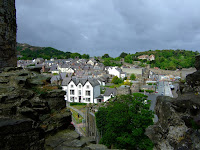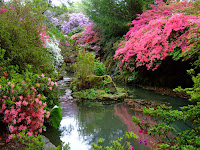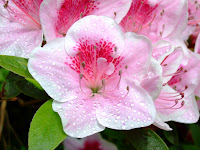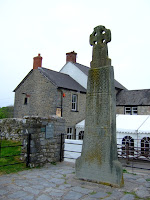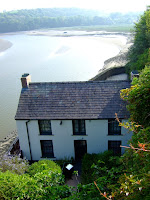 Although we left Stansted airport late we managed to arrive in Ljubljana by 4:20 p.m., collected our grey 'Soviet issue’ rental car and drove to the apartment we had booked and paid for through EasyJet.
Although we left Stansted airport late we managed to arrive in Ljubljana by 4:20 p.m., collected our grey 'Soviet issue’ rental car and drove to the apartment we had booked and paid for through EasyJet.The accomodation was described as a ‘hotel apartment’ but when
 we arrived at the address we found a 13-story ‘soviet issue’ residential apartment block with a card-access security entrance rather than the ‘hotel’ desk we were expecting. Some tenants arrived home, so we ‘shoulder surfed’ through the security door behind them, thus accessing the lobby. While trying to decide on our next move another couple of tenants arrived so we asked them if they spoke English and found that they did not.
we arrived at the address we found a 13-story ‘soviet issue’ residential apartment block with a card-access security entrance rather than the ‘hotel’ desk we were expecting. Some tenants arrived home, so we ‘shoulder surfed’ through the security door behind them, thus accessing the lobby. While trying to decide on our next move another couple of tenants arrived so we asked them if they spoke English and found that they did not.We knew the apartment was on the 12th floor, so took the lift up to have a look.
 Sure enough, there was a door with the apartment name we were looking for but it was firmly locked and there was no bell. Then the next door opened and it turned out that the non-English speaking folk we met in the lobby lived next door. (I think that they were expecting us to turn up on the landing and were waiting for us.) After a sign language exchange and showing them our booking confirmation the woman rattled off in Slovenian then indicated for us to wait while she went and rang the apartment owner who
Sure enough, there was a door with the apartment name we were looking for but it was firmly locked and there was no bell. Then the next door opened and it turned out that the non-English speaking folk we met in the lobby lived next door. (I think that they were expecting us to turn up on the landing and were waiting for us.) After a sign language exchange and showing them our booking confirmation the woman rattled off in Slovenian then indicated for us to wait while she went and rang the apartment owner who  appeared from the floor above, with a key. We have no idea how we would have got on without their help and the coincidence of meeting these helpful neighbours in the lobby.
appeared from the floor above, with a key. We have no idea how we would have got on without their help and the coincidence of meeting these helpful neighbours in the lobby.Apart from the practicalities of finding the place, it was a very well appointed apartment and reasonably handy to the city centre (if you have a car)
We drove into the city to have a look around. Dinner was a memorable meal: we decided to try a platter for two, which turned out to be a huge serving dish loaded with different types of meat and vegetables; there was enough meat on the plate for a week so
 we struggled to eat a delicious meal which could have fed a whole family.
we struggled to eat a delicious meal which could have fed a whole family.First impression of Slovenia is that they have a much more relaxed attitude to advertising images than we are used to, this billboard being a little more restrained than some.






